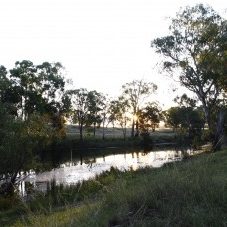Ecology and evolution

Ecology
Platypuses are opportunistic predators, feeding predominately on a variety of benthic macroinvertebrates, which they forage for in pool and riffle habitats of streams and rivers. They forage between 8 to 16 hours each day and, when not in the water, are most often found resting in burrows made in the sides of riverbanks. They typically utilize 0.5-15 km of river, with males moving greater distances than females (Bino et al. 2019). Juveniles can move larger distances, particularly males, with reports of movements more than 40 km from their natal sites (Serena & Williams 2012).
Platypus generation length is 9 to 12 years (Woinarski et al. 2014) or ten years (Furlan et al. 2012), calculated as the approximate mid-point between age at maturity (2 years; Grant et al. 2004) and maximum reported longevity in the wild (21 years; Grant 2004). In Melbourne creeks, median adult longevity for males is estimated to be 6.3 years and 6.5 years for females (Serena et al. 2014), but this is yet to be confirmed across the species’ range.
The maximum life span recorded for platypus is 21 years in the wild and 25 years in captivity, with most generally surviving 6 to 15 years (Bino et al. 2019).
They are seasonal breeders, breeding earlier in the year in lower latitudes: in NSW, breeding begins during August, with juveniles emerging from burrows between January and March compared to about two months later in Tasmania (Connolly & Obendorf 1998; Temple-Smith & Grant 2001).
During courtship, female and male platypuses engage in courting behaviour where the male platypus holds the tail of the female with its bill, although sometimes this is described as a “pounce and grab” with vigorous splashing before mating. The female then leads them through a series of slow twists and turns, followed by mating (Bino et al. 2019).
Females will then construct or utilise an existing nesting burrow where they typically lay one to three eggs, hatching to dependent nestlings (usually one or two).
Nestlings are suckled in the burrow for 120 to 140 days in captivity (Hawkins & Battaglia 2009; Thomas et al. 2018), but probably for a shorter period in the wild (Grant et al. 2004).
Habitat
Platypuses are mainly aquatic, but occasionally move across land between water bodies and river catchments for dispersal (Furlan et al. 2013; Kolomyjec et al. 2009; Scott & Grant 1997). Platypuses prefer rivers and streams with pool and riffle sequences of 1-5 metres depth (Bryant 1993; Ellem et al. 1998; Grant 2004; Rohweder 1992), typically diving less than 3m (Bethge 2002). The complexity of bed substrate is also important in determining habitat quality, with a combination of gravel, pebbles, cobbles, and various sizes of larger rocks being important characteristics (Grant 2004; Rohweder 1992; Serena et al. 2001).
Riparian vegetation is extremely important for platypuses, as it provides bank stability which is essential for the construction of burrows. Overhanging vegetation also provides in-stream organic material (Bryant 1993; Rohweder 1992; Serena et al. 2001). While all these factors are important for platypuses, they are found in a variety of habitats, many of which lack these characteristics, including degraded agricultural areas (Grant & Denny 1991; Rohweder & Baverstock 1999). Platypuses make burrows in the sides of riverbanks and generally prefer vegetation-consolidated banks greater than 0.95 m (Brunt et al. 2018). Resting burrows are up to three metres in length, with the entrances mainly occurring above the surface of the water. Their nesting burrows, which are up to 30m long, are constructed by females over one or more breeding seasons to house dependent offspring until emergence (Burrell 1927).
Evolution
Platypuses are monotremes, the most ancient lineage of mammals living today. Some 315 million years ago, mammals split off from reptiles and birds. Then, around 166 million years ago, when dinosaurs roamed the earth and the first flower evolved, monotremes branched into their own group.
